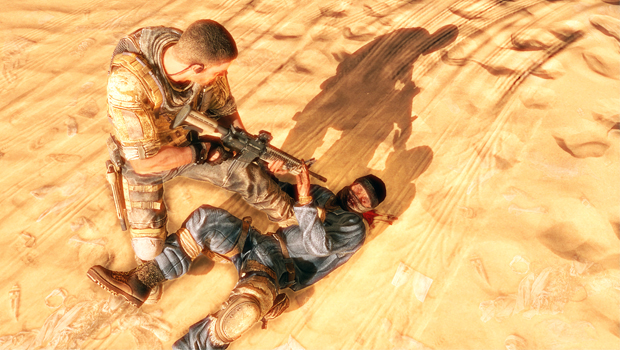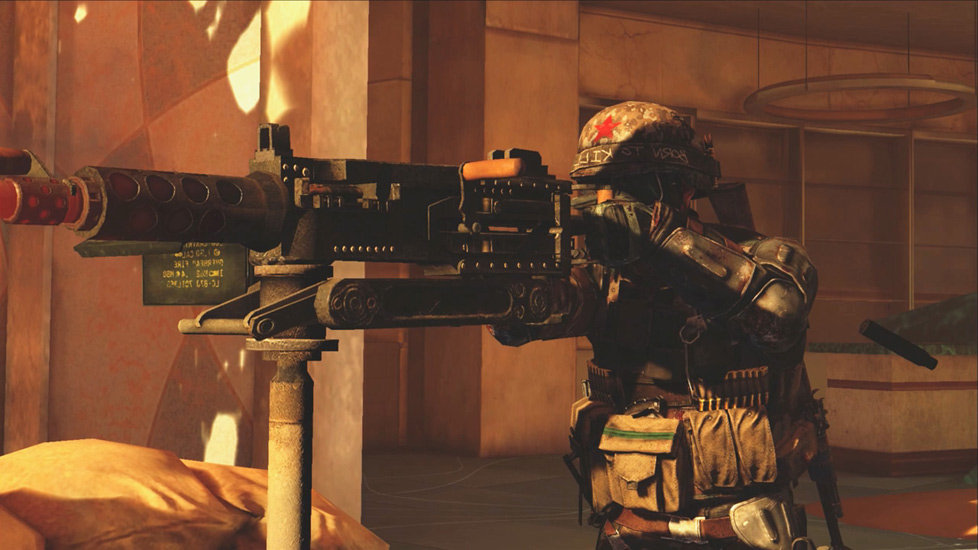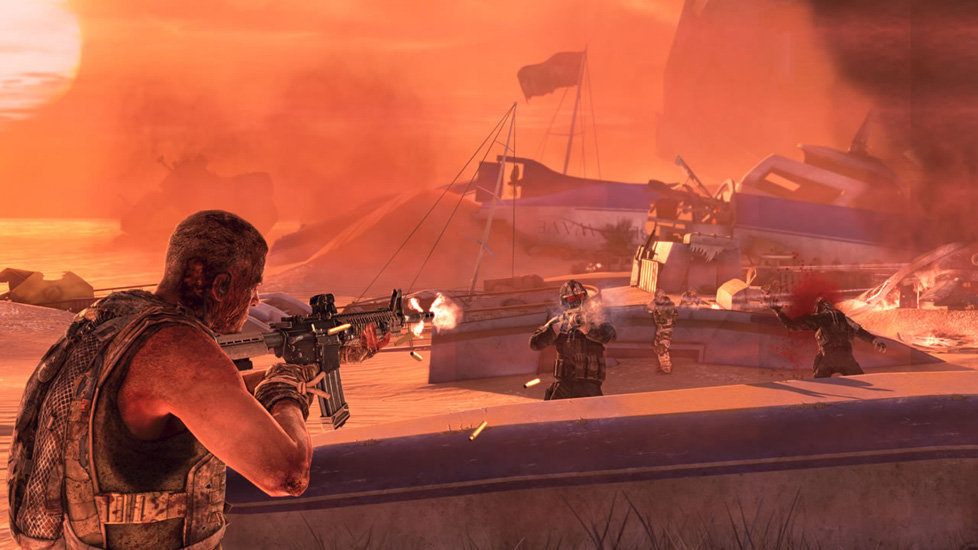|
Specs Ops the Line
Alone,
shell-shocked and bloody, you stagger into the impossibly opulent lobby
of a Dubai hotel. The walls on either side glow blue, and cast rippling
reflections on the floor. Brimming with brightly coloured fish, the
aquarium bears the illusion of limitless depth. This casual display of
wealth is as jarring as any of the horrors youve witnessed outside.
Looking up, you see a dim blue light filtering through the skeletal
framework of the tower; thats where youre headed. Clambering into the
elevator, with one half of your face caked in blood, you listen to the
gravely voice of the games antagonist as he quietly mocks you: Do you
feel like a hero yet?

Spec
Ops: The Line casts you as Captain Martin Walker, a Delta Force
operative. Along with your comrades Lugo and Adams, your task is to
investigate a radio signal originating in Dubai. Several months prior to
your arrival, Dubai was all but wiped off the map by the most vicious
sandstorm the world had ever seen. A U.S Colonel named John Konrad
(voiced by Bruce Boxleitner) led his 33rd battalion through
the storm in an attempt to evacuate survivors, but the mission was a
dead loss and everyone inside city limits was presumed dead. But the
radio signal has given the outside world hope: Konrad and his
damned
33rd may well be alive, and its
your job to get in and find out.

Combat
works like this: You can run, slide into and vault over cover. When you
take damage, the screen turns grey and bloodstains appear around the
edges. If you can avoid getting shot repeatedly, your health
regenerates. Indicators tell you which direction youre
being hit from and where the grenades are landing. Sound familiar? Thats
because youve
played a third person shooter made in the last 5 years.
Most of
the battlefields are littered with explosive barrels and crates. Being
dark red in colour, these are really hard to see from any distance, and
its
usually only after having cleared a room that youll
notice them.

While the
controls and interface may be enough to induce a potent sense of dιjΰ
vu, there are a few tweaks to the formula that make the gameplay feel at
least a little bit fresh. The grenade indicator will change from red to
white, depending on whether or not the pineapple is within lethal range.
After dying a few times, youll
also notice just how vulnerable you are to enemy fire. Stay in the open
for more than a second and youre
cactus.
The damage
model is just one hint that Spec Ops wants to distance itself from the
cool kids, and sit more towards the
simulation
end of the bus. Youll
be given some tactical control over your squad-mates, and this is
handled by pressing the context-sensitive right shoulder button. If youre
aiming at an enemy standing on a bridge, pressing the button will order
your sniper to give the baddie a little extra ventilation in his head
region. If youre
targeting a machine gun nest, your Lieutenant will charitably offer to
throw a grenade.
All-in-all, this one-button approach to squad control feels slightly
restrictive. It would be useful to be able to order your men into
position, or at the very least give them a simple
Stop
or Move
command. Too many times, one of them will burst from cover and be cut
down by enemy fire. When a squad mate goes down you can either order the
remaining one to revive him, or do it yourself. But if they both go down
in full view of the enemy it usually means curtains, as youll
be cut to ribbons while trying to administer the life-saving jolt in the
arm.
But for
all of those little foibles, there are a few big saving graces. There
are a handful of stealth sections which do a great job at breaking up
the action sequences. The setting of a sand-wracked Dubai is one of the
most interesting and eerie locales Ive
seen depicted in a game for quite some time. The first time you see it
close-up, the city glimmers like a scene from the cover of Omni
magazine.

Youll
creep through ornate hotel lobbies, fight your way down highways choked
with sand-blasted Lamborghinis, and rappel down the sides of glimmering
skyscrapers. But more so than the setting, its
the story that will keep you slugging away. Right from the beginning,
there are hints that The Line is hiding more up its sleeve than
youd
find in the average game narrative. The U.S Army is seemingly at war
with the CIA. Niches beneath underpasses are crammed with bodies. And
youre
frequently in contact with a demonic radio DJ, who seems to take delight
in it all.
The games
menu screen portrays a disquieting view: Looking over the endless dunes,
a sniper is camped under an inverted American flag. These are all clues
that The Line is somewhat different from the shooter norm. Youll
play on through the repetitive early sections, in the hope that the game
is building to something special.
And that
it is. Deep into the campaign, youll
be presented with what looks like an easy opportunity to destroy an
entire base of enemies. The method of doing this is completely
impersonal, so you dont
feel much of anything. But then the game forces you, literally, to walk
through what youve
done; to hear the consequences, to see them. And suddenly you dont
feel like a hero anymore. You feel ill.

As Walker
and his team probe deeper into Dubai, their mission goals become more
and more nebulous. The friendly banter disappears, and is replaced by
doubt, apprehension, and eventually, loathing. Towards the end, the only
thing keeping the group together is a dogged resolve to see things
through, and youll
feel this as a player as you scrape through each encounter.
It often
feels like youre
walking a moral tightrope. Seldom has a shooter made us feel as
accountable for our actions as we do in
The Line.
There is a very strong anti-war message here, but you
also get the impression that Yager development are having a subtle dig
at video game violence as well; which is a surprising and brave
viewpoint for a developer to have.
Closing
comments:
Spec Ops:
The Line
uses a
tried and tested shooter formula to deliver a powerful and
thought-provoking story. |